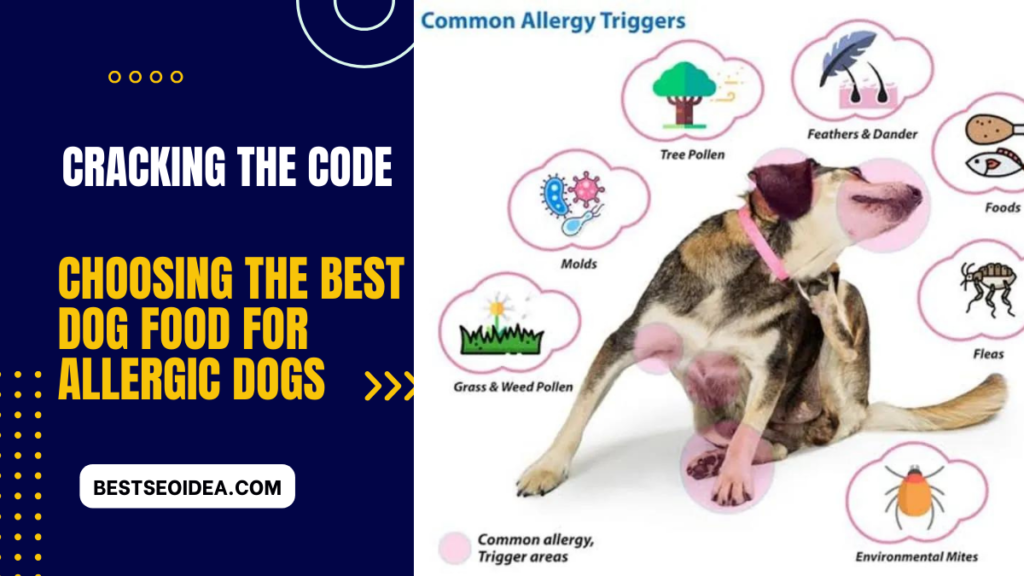Best Dog Food for Allergic Dogs: Does your furry friend suffer from itchy skin, constant ear infections, or digestive woes? Food allergies might be the culprit. But fret not, pawsome pet parent!
By navigating the dog food aisle with the right intel, you can find a food that soothes their tummy and keeps them scratching their happiness away.
Table of Contents
Cracking the Code: Choosing the Best Dog Food for Allergic Dogs
Food allergies can turn playtime into frustration for both you and your dog. Constant scratching, digestive distress, and recurring ear infections can be a real drag. But fear not, fellow dog lover!
By understanding your pup’s allergies and choosing the right food, you can transform those sad puppy eyes into happy wags.
Step 1: Seek a Diagnosis

While it’s tempting to dive headfirst into different dog food options, a visit to your veterinarian is crucial. They can perform tests to confirm a food allergy and identify the specific triggers. This eliminates guesswork and ensures a faster path to relief.
Step 2: Decoding the Diet Options
Once you have a diagnosis, here’s a breakdown of the best food choices for your allergic pup:
- Hydrolyzed Protein Diets: Imagine breaking down proteins into tiny fragments unrecognizable by your dog’s immune system. That’s the magic of hydrolyzed protein diets! These prescription wonders are often the first line of defense for managing allergies.
- Limited Ingredient Diets: Think simplicity is key! These diets contain a single protein source (like kangaroo or duck) and limited carbohydrates, making it easier to pinpoint the culprit if your dog reacts.
- Novel Protein Diets: Introduce a protein your dog has never encountered before, like venison or rabbit. This approach helps identify allergies to common ingredients like chicken or beef.
- Grain-Free Options: While not a guaranteed solution, some dogs with allergies have sensitivities to grains like wheat, corn, or soy. Grain-free alternatives with alternative carbohydrates like potatoes or lentils can be worth exploring.
Step 3: Read Between the Lines
When selecting a food, become a label-reading detective! Look for:
- AAFCO Statement: Ensure the food meets the nutritional needs for your dog’s life stage (puppy, adult, senior) as per the Association of Animal Feed Control Officials (AAFCO).
- Limited Ingredients: Fewer ingredients mean fewer potential allergens.
- High-Quality Protein Source: Look for meat listed as the first ingredient, ideally a novel protein if recommended by your vet.
Taming the Itch: A Personalized Path to Food Bliss for Your Allergic Dog

Is your dog scratching their way to a symphony of frustration? Food allergies could be the conductor behind this itchy orchestra. But fear not, fellow pet parent!
By understanding your dog’s unique needs and navigating the dog food aisle strategically, you can find the perfect food to turn down the volume on those allergies.
Food for Thought: Consulting a Vet is Key
While the internet might be overflowing with “miracle” allergy-busting foods, a trip to your veterinarian is the first step towards real relief. Diagnostic tests can pinpoint the exact ingredients triggering your dog’s woes.
This personalized approach saves time, money, and most importantly, keeps your furry friend comfortable.
Decoding the Allergy Alphabet Soup

Once you have a diagnosis, here’s a cheat sheet for navigating the world of allergy-friendly dog food:
- The “Sherlock Holmes” Approach: Elimination Diets: Work with your vet to create a limited ingredient diet featuring a single, novel protein source your dog has never encountered before. This detective work helps identify the allergy culprit. Think kangaroo or duck instead of the usual chicken or beef suspects.
- The “Peace Offering” Option: Hydrolyzed Protein Diets: Imagine breaking down proteins into unrecognizable fragments for your dog’s immune system. That’s the magic of hydrolyzed protein diets! These prescription wonders are often highly effective in managing allergies.
- The “Less is More” Philosophy: Limited ingredient diets keep things simple. By using a single protein source and limited carbohydrates, these diets minimize the potential for allergic reactions.
Pro Tip: Reading the Label Like a Pro
When choosing a food, transform into a label-reading champion! Here’s what to watch for:
- The AAFCO Seal of Approval: Look for the AAFCO (Association of American Feed Control Officials) statement, ensuring the food meets your dog’s specific nutritional needs for their age and life stage.
- Ingredient Spotlight: Fewer ingredients mean fewer potential allergens. Focus on a limited ingredient list with a novel protein source listed first.
- Quality Counts: Look for high-quality protein sources like meat listed as the first ingredient.
Top 5 Best Dog Food In 2024 | Food Allergy Testing
Bonus Tip: Patience is Pawsome
Remember, identifying and managing allergies takes time. Stick to the recommended diet for at least 8-12 weeks to see a difference. If your dog shows improvement, you’ve cracked the allergy code! Consult your veterinarian for ongoing guidance and celebrate a happier, healthier pup.
Friends, You may visit my web story section for more trending entertainment news, and upcoming movie trailers. You may join my Twitter Account for more news updates, Wordle, and more games answers and hints daily.
You would like to read these posts
10+ New Wellhealth Ayurvedic Health Tips to Keep Yourself Always Fit
7 Easy Ways to Reduce Belly Fat Without Exercise, 4S Reasons, And Dangerous Effects
Bite-Sized Happiness: 7 Foods to Uplift Your Mood (and Taste Buds!)
Finding Your Perfect Fit: Best Cities to Live in North Carolina for Different Lifestyles